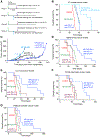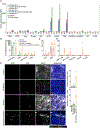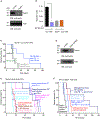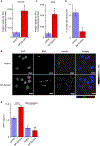Fascin inhibitor increases intratumoral dendritic cell activation and anti-cancer immunity
- PMID: 33826900
- PMCID: PMC8050791
- DOI: 10.1016/j.celrep.2021.108948
Fascin inhibitor increases intratumoral dendritic cell activation and anti-cancer immunity
Abstract
Fascin protein is the main actin-bundling protein in filopodia and invadopodia, which are critical for tumor cell migration, invasion, and metastasis. Small-molecule fascin inhibitors block tumor invasion and metastasis and increase the overall survival of tumor-bearing mice. Here, we report a finding that fascin blockade additionally reinvigorates anti-tumor immune response in syngeneic mouse models of various cancers. Fascin protein levels are increased in conventional dendritic cells (cDCs) in the tumor microenvironment. Mechanistically, fascin inhibitor NP-G2-044 increases the number of intratumoral-activated cDCs and enhances the antigen uptake by cDCs. Furthermore, together with PD-1 blocking antibody, NP-G2-044 markedly increases the number of activated CD8+ T cells in the otherwise anti-PD-1 refractory tumors. Reduction of fascin levels in cDCs, but not fascin gene knockout in tumor cells, mimics the anti-tumor immune effect of NP-G2-044. These data demonstrate that fascin inhibitor NP-G2-044 simultaneously limits tumor metastasis and reinvigorates anti-tumor immune responses.
Keywords: Fascin; IL-12; anti-PD-1; antigen uptake; cancer immunotherapy; dendritic cells; fascin inhibitors; immune checkpoint inhibitor; interferon gamma; tertiary lymphoid structure.
Copyright © 2021 The Author(s). Published by Elsevier Inc. All rights reserved.
Conflict of interest statement
Declaration of interests Novita Pharmaceuticals supported part of the work through a Sponsored Research Agreement. X.-Y.H. and J.J.Z. are co-founders and have equity in Novita Pharmaceuticals.
Figures







Similar articles
-
Improving fascin inhibitors to block tumor cell migration and metastasis.Mol Oncol. 2016 Aug;10(7):966-80. doi: 10.1016/j.molonc.2016.03.006. Epub 2016 Apr 1. Mol Oncol. 2016. PMID: 27071719 Free PMC article.
-
Immune checkpoint Ab enhances the antigen-specific anti-tumor effects by modulating both dendritic cells and regulatory T lymphocytes.Cancer Lett. 2019 Mar 1;444:20-34. doi: 10.1016/j.canlet.2018.11.039. Epub 2018 Dec 10. Cancer Lett. 2019. PMID: 30543813
-
In situ immunization of a TLR9 agonist virus-like particle enhances anti-PD1 therapy.J Immunother Cancer. 2020 Oct;8(2):e000940. doi: 10.1136/jitc-2020-000940. J Immunother Cancer. 2020. PMID: 33060147 Free PMC article.
-
In situ delivery of iPSC-derived dendritic cells with local radiotherapy generates systemic antitumor immunity and potentiates PD-L1 blockade in preclinical poorly immunogenic tumor models.J Immunother Cancer. 2021 May;9(5):e002432. doi: 10.1136/jitc-2021-002432. J Immunother Cancer. 2021. PMID: 34049930 Free PMC article.
-
Functions of fascin in dendritic cells.Crit Rev Immunol. 2012;32(1):11-21. doi: 10.1615/critrevimmunol.v32.i1.20. Crit Rev Immunol. 2012. PMID: 22428853 Review.
Cited by
-
The combined tumour-based Fascin/Snail and stromal periostin reveals the effective prognosis prediction in colorectal cancer patients.PLoS One. 2024 Jun 27;19(6):e0304666. doi: 10.1371/journal.pone.0304666. eCollection 2024. PLoS One. 2024. PMID: 38935747 Free PMC article.
-
TMEM52B Isoforms P18 and P20 Differentially Promote the Oncogenesis and Metastasis of Nasopharyngeal Carcinoma.Adv Sci (Weinh). 2024 Sep;11(33):e2402457. doi: 10.1002/advs.202402457. Epub 2024 Jun 28. Adv Sci (Weinh). 2024. PMID: 38940427 Free PMC article.
-
Dendritic Cell-Based Immunotherapy: The Importance of Dendritic Cell Migration.J Immunol Res. 2024 Apr 8;2024:7827246. doi: 10.1155/2024/7827246. eCollection 2024. J Immunol Res. 2024. PMID: 38628676 Free PMC article. Review.
-
Lactate-mediated Fascin protrusions promote cell adhesion and migration in cervical cancer.Theranostics. 2023 Apr 17;13(7):2368-2383. doi: 10.7150/thno.83938. eCollection 2023. Theranostics. 2023. PMID: 37153736 Free PMC article.
-
Effects of imipramine on cancer patients over-expressing Fascin1; description of the HITCLIF clinical trial.Front Oncol. 2023 Sep 29;13:1238464. doi: 10.3389/fonc.2023.1238464. eCollection 2023. Front Oncol. 2023. PMID: 37841433 Free PMC article.
References
-
- Barry M, and Bleackley RC (2002). Cytotoxic T lymphocytes: all roads lead to death. Nat. Rev. Immunol 2, 401–409. - PubMed
-
- Bros M, Ross XL, Pautz A, Reske-Kunz AB, and Ross R (2003). The human fascin gene promoter is highly active in mature dendritic cells due to a stage-specific enhancer. J. Immunol 171, 1825–1834. - PubMed
-
- Bryan J, and Kane RE (1978). Separation and interaction of the major components of sea urchin actin gel. J. Mol. Biol 125, 207–224. - PubMed
-
- Cabrita R, Lauss M, Sanna A, Donia M, Skaarup Larsen M, Mitra S, Johansson I, Phung B, Harbst K, Vallon-Christersson J, et al. (2020). Tertiary lymphoid structures improve immunotherapy and survival in melanoma. Nature 577, 561–565. - PubMed
Publication types
MeSH terms
Substances
Grants and funding
LinkOut - more resources
Full Text Sources
Other Literature Sources
Medical
Research Materials
Miscellaneous

